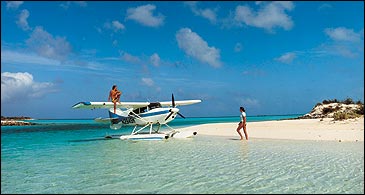There’s a swoosh of heaven that runs from Hawaii through Mexico to Central America and the Caribbean. Don’t let it bask in the sun by itself. Our 43 sweet spots are waiting—surrender and go.
By James Glave
By Meg Lukens Noonan
By Kevin Moeller
By Jeff Hull
By Kent Black
Trailing Off on Kauai
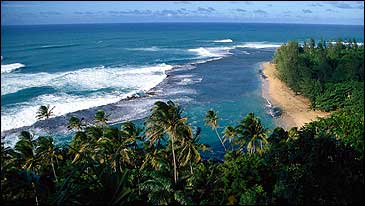
THE DETAILS
The Kalalau Trail is a 22-mile round-trip recommended for experienced backpackers. Camping is allowed in designated sites at Kalalau Valley, at the 6.5-mile mark on the trail, and at some points along the beach. A backcountry permit is required to hike beyond Hanakapi’ai Beach. Permits to camp cost $10 per person per night and should be booked at least a year in advance. For information, call 808-274-3444.It was our first morning in paradise. The deserted white beach at our tent flap stretched a quarter-mile out to the breakers. The backdrop was a sheer-walled green valley┬Śsome oo aa birds flitting over ancient taro terraces thick with wild guava trees, orchids, and vines. Off to our left, nubile twentysomethings splashed naked under a beachside waterfall. It was almost too much to take.
So why were the neighbors packing up already?
Most who make the grueling, full-day 11-mile trek to the Kalalau Valley, an isolated outpost at the far eastern end of Kauai’s spectacular Na Pali Coast, rest on the sand for at least a day. Many take time to explore the lush highlands and visit with the dozen-odd “full-timers” who, dodging Hawaii State Parks regulations, have formed a tropical microsociety straight out of a certain Leo DiCaprio box-office flop.
But these two hikers were acting like they were late for work. We’d met them the day before on the hike in; now they were hoofing it in toward Red Hill, a steep, sun-scorched 360-foot slope that you must descend into the valley, fully aware of the work it will take to climb back up it on the way home.
“Wait, didn’t you just get here?” I asked.
The boyfriend came over and lowered his voice. “Don’t you know how it works here?” We didn’t.
“First they invite you in on a game of chess, right?” He looked around, fidgeting. “Next thing you know, the afternoon is gone, and someone’s offering you roast wild goat for dinner. And then you’re waking up the next morning and that┬Śhe motioned toward Red Hill┬Ślooks like a lot of work. So you hang around for another day. And play some more chess. And the day turns into a week . . .”
His girlfriend rolled her eyes. She clearly wasn’t buying his Aloha Moonies theory.
Neither were we. My wife, Elle, and I were savoring our first taste of wild Hawaii. Our mud-and-sweat adventure had begun after we crossed the Hanakapi’ai River┬Śthe Kalalau Trail’s two-mile mark and the mandatory turnaround point for day hikers. We ascended 5,000 feet, seesawing in and out of five valleys along the only hikeable stretch of the Na Pali Coast.
Protected by steep pali, or cliffs, the Kalalau Valley is the perfect hideout. It was here in this jungle in the 1880s that an ailing fugitive and his wife eluded authorities for years┬ŚJack London immortalized them in his 1908 story “Koolau the Leper.” Taro farmers populated the valley until the early 20th century. The hippies came later.
We found much to like in this Eden, including a series of deserted waterfall pools deep in the forest. After leaving our beachside homestead, we blew hours goofing off, swimming, exploring, sticking our noses into wild lilies. Heading back, we met one of the residents, dragging a folding chaise lounge┬Śhow the heck did he get that in here?┬Śalong the sand.
“Jay” is a high school gym teacher who lives in Kalalau during the off-season. He’s terribly mellow and powerfully muscled, sporting a shark-tooth necklace and not much else.
How does he survive here? “I have friends all over the island who help me out,” Jay said, adding that he also pulls papio and moi fish from the surf and hunts goats in the backcountry. After a few minutes, the conversation wound down, and Elle and I headed off to explore the nearby sea caves.
Then Jay called after us. “Hey . . . do you play chess?”
The Ins and Outboards of the Exumas
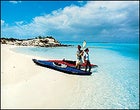 Beached: solitude off the Exumas Cays
Beached: solitude off the Exumas CaysCut your boat engine in the clear water of the Bahamas’ Exuma Cays and who knows what will appear: a five-foot lemon shark swimming slow S-curves under your hull, a pair of stealthy eagle rays, clumps of conch shells among purple barrel sponges, even a family of swimming pigs—yes, pigs—which, long abandoned by their owners, live quite well off their pink good looks and the Wheat Thins tossed overboard by boaters. This bountiful 100-mile strand of 365 narrow, mostly uninhabited islands, bounded by the cobalt depths of the Exuma Sound to the east and the aquamarine shallows of the Great Bahama Bank to the west, is amazingly only 40 miles from the Vegas-like excesses of Nassau. But when you drop anchor on one of the cays’ empty, wild, bisque-colored beaches, you might as well be on the other side of the big blue world.
A peripatetic island escape begins at quiet Staniel Cay in the center of the Exuma chain. Book one of the Staniel Cay Yacht Club’s snug pastel cottages—each comes with a 13-foot Boston Whaler powerboat—in advance. Then spend a week day-tripping your way around these narrow, close-together islands, some barely the size of a major league pitching mound, others large enough to support a fishing village, a beach resort, and a couple of open-air bars serving conch fritters and Kalik beer. Don’t worry about your sketchy navigational skills—these are nearly idiotproof cruising waters. You need only your eyes to figure out how to get to your next anchorage. A fairly reliable sense of how shallow is too shallow for your boat will help, too.
One day you might focus on fishing, working the shimmering bonefish flats of Harvey Cay and Pipe Creek, about three miles from Staniel Cay, or angling around Exuma Sound Ledge, a thousand-foot drop-off just a few hundred yards offshore. On another day, motor to Thunderball Grotto, a snorkel-through cave, swing by “Pig Beach” on Major Spot Island, and then visit Compass Cay, where you’ll be greeted by a group of creepily Pavlovian nurse sharks looking for handouts. Make the short walk to the bluff-backed crescent of sand on Compass Cay’s east side and spend the rest of the day prone. Or head south one morning to Bitter Guana Cay (no need to know how it got its name), where you’ll see iguanas prowling the beach, and stop on another island, Great Guana Cay (don’t ask), for cracked conch with the locals at Lorraine’s Cafe.
Plan on taking a couple of days to explore the pristine reefs and coves of the Exuma Land and Sea Park, a 176-square-mile, no-take preserve (no fishing, no collecting) overseen by the Bahamas National Trust, where you can also hike the four miles of trails near Warderick Wells. The park begins at Conch Cut, about five miles northwest of Staniel, and ends 22 miles north at Wax Cut Cay.
Most evenings, you’ll be content hanging out in the Staniel Cay Yacht Club’s dockfront bar, eavesdropping on the catch-drunk anglers and hypertanned nomadic yachties. Save one night, though, for dinner in the hilltop clubhouse at Fowl Cay, a swank new three-cottage resort about a mile and a half by boat from Staniel Cay. You should know, however, that this is one very classy place—shoes are mandatory.
THE DETAILS:
Flamingo Air flies from Nassau to Staniel Cay every day but Saturday for $70 one-way (242-377-0354, ); from Fort Lauderdale, many companies charter planes to Staniel Cay—try Island Air Charters ($900 for up to seven people; 800-444-9904, ), or from Nassau, Air Charter Bahamas ($590 for up to five people; 305-885-6665, ). Cottages at Staniel Cay Yacht Club (242-355-2024, ) start at $167 per person per night and include a 13-foot Boston Whaler. At Fowl Cay Resort (866-369-5229, ), cottages start at $4,750 per week for two people, including meals, beverages, and a 17-foot boat. For information on the Exuma Land and Sea Park, visit .
Off Belay on Culebra
THE DETAILS:
Flights on Isla Nena Air (877-812-5144) from San Juan cost $70, one-way; hop the ferry for $4. Camping at Flamenco Beach (787-742-0700) costs $20 per night, or stay in a cottage with a kitchen and deck at Tamarindo Estates, right on the Luis Pe-a Marine Reserve, for $170 per night (787-742-3343, ). For climbing advice, call Aventuras Tierra Adentro in San Juan (787-766-0470, ). For general information, visit .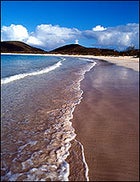 Flamenco Beach: Culebra’s prized possession
Flamenco Beach: Culebra’s prized possessionWhen I took off for Culebra, a seven-mile-long island outpost east of Puerto Rico with a stash of oceanside face climbing, I had every intention of spending my time on the rocks. I was ready for the feel of sea spray on my back while working 5.10 friction moves. But then I discovered how the sleepy rhythms of an undeveloped island can get in the way of any serious ambition.
Like Vieques, its neighbor to the south, Culebra is part of the Commonwealth of Puerto Rico and has played host to Navy bombing practice, though things have quieted down since the 1970s, when locals protested to stop the ordnance rain. In fact, everything is quiet. There are no sprawling resorts or gaudy casinos, just one town, Dewey, and 1,542 Spanish-speaking islanders. There are opportunities for adventure—sea kayaking, sailing, diving, and of course climbing. You just have to fend off total lethargy to get to them.
Flamenco Beach is Culebra’s prize possession, with consistently clear water and a mile of silky white sand. To get there, visitors take a 20-minute flight from San Juan aboard a prop plane, which buzzes over scrubby dry-tropical forest before dropping with a gulp onto the lone landing strip; I walked, sandals flapping, the mile and a half to Flamenco Beach. Weekends can bring ferryloads of Puerto Rican families, but even then there’s little competition for sandy real estate. Find yourself a vacant acre, plop down under a palm . . . and erase those Jersey Shore memories of folks stacked around you like frankfurters on a Weber.
Restless beachgoers strap on masks to eyeball hogfish and schools of tang just offshore, or they boogie-board the shoulder-high breakers at the beach’s south end. A mile-long dirt path leads to neighboring Carlos Rosario beach, which borders the Luis Pe-a Marine Reserve—part of the island’s 1,568 acres of wildlife refuges—where snorkelers snoop the seagrass beds for conchs. In the deeper waters of the reserve, near Cayo Yerba, divers swim with stingrays among huge boulders festooned with yellow cup corals.
I eyed the trail to my intended destination, the Punta Molinas climbing area, an hour and a half of ridge hiking from the beach parking lot. The volcanic crag, riveted with bolts covered in sea salt, is a humble 30 feet or so high, but the routes are 5.9 to 5.10—and the views of the Caribbean while dangling from a flake are expansive. Most times you share them with no one. But the afternoon slipped by, so I pitched my tent at Flamenco’s campground—surf 20 feet away—and watched a spearfisherman amble along with a dive bag full of red snappers, conchs, and lobsters, all of it hunted in a single lagoon.
By the next day, I’d let island time have its way with me and simply abandoned my notions of climbing. Too much work. I prowled around Dewey, stopping in a restaurant, El Caobo, where the cook pulled me into the kitchen to taste her guisada (chopped pork stew), handing me a spoonful with a smile. I ate a helping with fried snapper. Instead of being pumped out, knuckles bleeding, I sat there with a full belly and a sweating glass of Coca-Cola, slightly sunburned and utterly content.
THe Breezes Of Belize
THE DETAILS:
Flights between Belize City and Placencia cost $140 round-trip on Tropic Air (800-422-3435, ). The Moorings (888-952-8420, ) has a fleet of boats for bareboat or crewed sailing out of Placencia. Offshore, Ranguana Caye rents three cabanas that sleep four people each ($500 per week; 011-501-523-3227, ). For more lodging, and outfitters, contact Destinations Belize (011-501-614-7865, ). Destination wet: the distant allure of Goff Kay
Destination wet: the distant allure of Goff KayRead Kerr steered our 38-foot catamaran through a quartering chop off the southern coast of Belize. “Gee, Read,” I said, “kind of a rough ride. Can’t you smooth it out a little?”
“I’m not in charge of the ocean,” replied ten-year-old Read. “I’m only in charge of the boat.”
That was the tone for this eight-day sailing sojourn among Belize’s southern cays, a smattering of islands—some inhabited, none larger than a square mile—sprinkled between the coastal village of Placencia and the Mesoamerican Reef, the largest barrier reef in the Western Hemisphere. The cluster of elkhorn and ivory bush corals, among others, stretches 450 miles from Mexico’s Yucat├ín Peninsula to the Bay Islands of Honduras, and is 20 miles offshore here.
A few days earlier, my friend Onne van der Wal (a nautical photographer and seasoned sailor), his wife, their three children, and I had chartered a sailboat without a captain (a.k.a. a bareboat). We left from Placencia, a friendly, quiet village of about 500 residents made even quieter in October 2001 when Hurricane Iris obliterated 80 percent of the structures in town and killed 22 people, including 17 American divers. We headed 20 miles east-southeast to Ranguana Caye, a spit of sand with palm trees and turquoise bungalows. Read and her younger brothers hit the water the moment the anchor did, gamboling like porpoises amid massive leaf corals.
Belize, Central America’s only English-speaking country, has 1,000-foot-wide barrier reef atolls to dive, 100-pound tarpon off Ambergris Cay to catch, and Mayan temples to explore. But from the moment Read enlightened us about her responsibility vis-├á-vis the sea, we freed ourselves from agendas. We were dinking around the outposts, dropping anchor alongside coral castles, and exploring former pirate haunts. We might cruise Punta Ycacos Lagoon in hopes of spotting manatees. Or we could swim with hawksbill turtles in the marine preserve at Laughing Bird Caye. We’d decide all this later.
Following Ranguana Caye, we ran 15 miles in an afternoon to the Sapodilla Cays, the southernmost islands. That evening Onne puttered the dinghy to a fishing panga and swapped two quarts of pineapple juice and a frozen key-lime pie for just-speared snapper fillets—dining out, cays style.
On one of our last nights, everyone retired to the cabins, leaving me on deck to sleep under the full moon. Clouds stole across the sky like great white secrets. Exhausted, I tried to remember how I got so tired: woke at sunrise, kayaked to a broad turtle-grass flat, waded around stalking bonefish and permit, paddled back, snorkeled. Not such a mystery after all. I started to think about the next day and realized that . . . well, I am not in charge of tomorrows.
Just Park Me in a Palapa in Yelapa
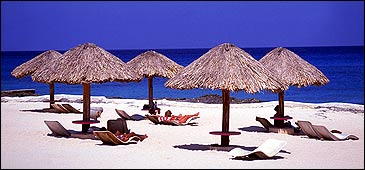
Rocky’s shrill whistle pierced through the sound of waves crashing beneath my bedroom. Untangling myself from mosquito net and sheet, I lurched out to the balcony of my two-story casita to peer at the dark pre-dawn ocean. Rocky, my beachfront neighbor and a former fishing guide from Arkansas, was gliding past in his sea kayak, trolling with a simple hand line of 30-pound test and a two-inch lure. He jabbed his paddle in my direction. Vamos!
I sighed. It was going to be another routine day in Yelapa, a fishing village 12 miles southwest of Puerto Vallarta on Mexico’s Pacific coast. Getting to the 1,200-person settlement requires a bumpy 30-minute ride by outboard water taxi south from Puerto Vallarta, along the rocky coast of the Bah’a de Banderas to Yelapa’s little hidden cove.
I’d start the day by joining Rocky to fish along the southern edge of the bay, Mexico’s largest, through schools of porpoises and the occasional manta ray, and past cliffs alternating with uninhabited, palm-laden lagoons. If I was lucky I’d come home with some tasty fish—known locally as sierras—for ceviche. By midmorning I’d be back at my rented casita cleaning my catch, eating a late breakfast of mangos, and pretending to write in my journal while staring out at the Pacific.
My first hard decision would be whether to hike or swim next. If the onshore wind seemed steady and strong, it might be a good day to hike two and a half hours to the top of one of the 2,000-foot summits that nearly surround Yelapa—a derelict ranchito atop one peak is a favored takeoff spot for parasailors. Or I could swim a half-mile from the casita to the center of Yelapa’s main beach, where lollygagging and slurping fresh shrimp cocktails are the main pursuits. I’d squeeze in a siesta, of course, and then make my way to the south end of the beach, where steps lead up to the town—a maze of adobe walls and red-tile roofs crisscrossed by cobblestone lanes. There are no cars or motorcycles in Yelapa, though there is traffic of a sort. Mules, the taxi/truck/car/bus of Yelapa, provide the only overland way out of town, up narrow mountain trails that would make even the hardiest SUV stall.
About two years ago, the town got electricity. Some people lamented this progress, though its only real results are television, two dozen streetlights, and too much Ricky Martin played late into the night. And the placid village has adapted itself to more vigorous visitors: Sea kayaks can be rented from Hotel Lagunita or Casa Isabel, local fishermen at the docks arrange day trips, and Miller’s Dive Service offers multiday trips to the small islands in the bay.
I might contemplate these changes as I prepare for a twilight fishing jaunt. Unless, of course, it’s game night. The locals (Raicillas) and the gringos (Bimbos) play softball three or four nights a week at a dusty field a mile up the R├şo Tuito from town. The game starts around 5 p.m. and ends eight or nine innings later or when you can’t see the ball—whichever comes first. After several hundred games, the series is just about even.
If the innings are quick, there’s time to get back to the casita for a cocktail and sunset observation. Then it’s a short walk to satisfy my addiction to the barbecued chicken, fish, and ribs served at Pollo Bollo. By 10 p.m. it’s time to tuck myself under the mosquito net—where the rhythm of the waves will anesthetize me until Rocky’s whistle wakes me again.
Yep, same old routine.
THE DETAILS:
Boats bound for Yelapa leave at 11:45 a.m. Monday through Friday in front of the Hotel Rosita in Puerto Vallarta (about $9.50 per person one-way; 011-52-322-223-2000, ). Cabanas for two at Hotel Lagunita (011-52-329-298-0554, ) cost $45-$75 per night; the hotel offers kayak rentals and guided waterfall hikes. Casa Isabel (; e-mail, Isabel@yelapa.com) also has kayaks and rents five palapas that sleep two to six people for $45-$75. Miller’s Dive Service (; e-mail, millersdiveservice@juno.com) offers five-day dive packages for $165 to $175 for two-tank dives. For fishing and kayaking with Rocky, contact his company, Yelapa Extreme Kayaking (rockmoninoff@hotmail.com).



